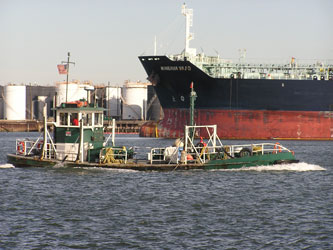Capt. Rich Naruszewicz, at the helm of Capt. Log, issues his radio sécurité call while crossing New York Harbor.
“Vessel Traffic, Capt. Log, coming out of Buttermilk Channel, entering Erie Basin.” Moments later, that’s followed by, “Vessel Traffic, Capt. Log, we are inbound The Cut.”
That radio transmission is music to the ears of vessel operators along the Brooklyn, N.Y., waterfront. It means the 63-foot vessel is arriving to deliver fuel to their fleet. Capt. Log, built in 1979, is one of the last single-hull harbor tankers still operating in New York Harbor.
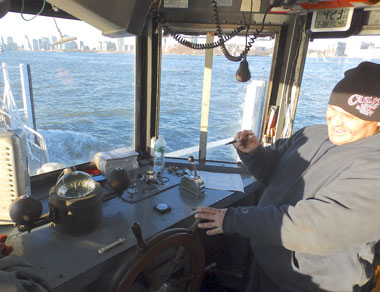 |
|
Capt. Rich Naruszewicz is master of the vessel for American Petroleum & Transport Inc. |
With a 20,000-gallon capacity, the 35-year-old Capt. Log still departs its dock along the West Side of Manhattan in the wee hours each morning to refuel numerous water taxis, tour boats, dredges, yachts and even large ships.
Although the vessel is equipped with modern electronic components including a Furuno 10-inch radar and Standard Horizon Explorer primary VHF radio, Naruszewicz likes to portray Capt. Log and its two-man crew as a no-frills workhorse from days gone by. The original 170-hp six-cylinder Detroit Diesel 671 engine still propels the steel-hulled tanker around the harbor.
“It’s a motor, a steering wheel and a compass. Bare boat. We’re old-school. We’re cave men — hawespipers,” Naruszewicz explains while navigating eastbound around The Battery. “When everybody’s sleeping, we’re going around delivering fuel. Sometimes we crisscross this harbor four or five times a day.”
On this particular morning, Capt. Log sailed into Erie Basin to deliver ultra-low-sulfur diesel to three New York Water Taxi vessels — Curt Berger, Marian S Heiskell and Sam Holmes. The harbor tanker eases up alongside the docked passenger boats, positioning itself first with its starboard bow to Curt Berger’s stern. Deck hand James Bragoli prepares the 2-inch hoses with Quick Connect coupling, and a pair of Blackmer positive displacement pumps will move the fuel. Naruszewicz faithfully fills out the Declaration of Inspection Prior to Bulk Oil Transfer form.
At the dock to greet the men and help connect the mooring and fuel lines is Robert Haywood, the New York Water Taxi port captain. Haywood praised the professionalism and convenience of the deliveries.
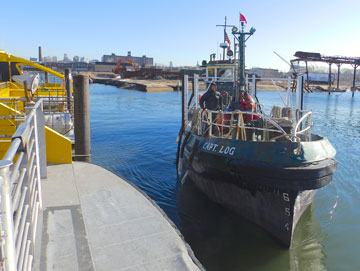 |
|
Capt. Log eases into position at the New York Water Taxi berths in Brooklyn. |
“Anytime that little Capt. Log comes in here to refuel, it’s really ideal,” Haywood said. “It saves us time, it saves us money, it helps us a lot and it’s a great way to go.”
In past years, the water taxis visited various dockside facilities to refuel. Sometimes it was first-come, first-served. Vessels would be queued up, unable to control or predict when they would be able to depart.
“We had to call ahead of time to see if they had an opening, and if so, we still might have to wait and we might have to take a boat out of service. It was very tough,” Haywood said. “Having the fuel service come in, it’s really great. You want to be able to do it as efficiently and safely as possible. These guys know how to fuel our vessels properly.”
Capt. Log is operated by American Petroleum & Transport Inc., based in Miller Place, N.Y. The boat is owned by Circle Line Sightseeing Cruises, which provides about 20 percent of the harbor tanker’s business. The remainder of the demand for the fuel service comes from the ferries and other sightseeing operators. Sometimes the boat refuels large commercial ships at anchorage. In the summer, foreign yachts visit New York Harbor and Naruszewicz is happy to rendezvous.
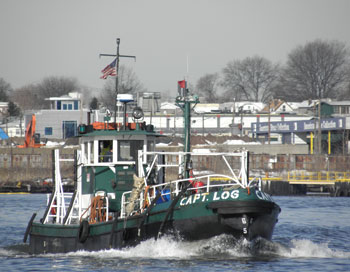 |
|
Photos by Will Van Dorp The harbor tanker Capt. Log, with a capacity of 20,000 gallons, delivers fuel to a variety of commercial-marine customers around New York Harbor. |
The companies own and operate two other harbor tankers — Scotty Sky and Patrick Sky. They are the last three harbor tankers that still deliver diesel in New York Harbor. Because all three are single-hull, they will be phased out of U.S. service by 2015. A new double-hull tanker will replace Capt. Log. Until then, the boat works every day, unless there is a gale warning over 34 knots or an ice condition in the Hudson River.
After filling up the three water taxis, Capt. Log exited Erie Basin. Next stop: Manhattan’s East Side to deliver fuel to two larger tour vessels: Hornblower Infinity and Classic Harbor Line’s Manhattan, which required a port-to-starboard approach. Earlier in the morning, the tanker serviced Hornblower Serenity.
Naruszewicz approached Serenity with Capt. Log’s starboard side coming along the customer’s port side and settling midship. The men tied up at multiple points with a forward spring line, after spring line and stern line on the port-side cleats. The tour vessel received its 1,000-gallon order in about eight minutes. Capt. Log’s fueling rate is as fast as 200 gallons per minute when both pumps are used.
Along the Hudson River, the main hazard for the fueling operation are wakes from larger vessels, especially ferries. Bragoli takes care to check the hose connections and the position of the fuel and mooring lines.
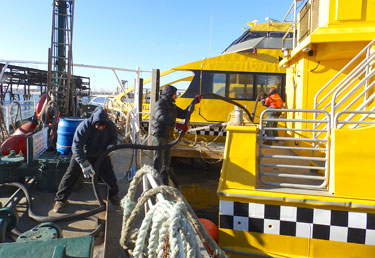 |
|
Naruszewicz and deck hand James Bragoli handle a fuel line, together with New York Water Taxi port captain Robert Haywood aboard Curt Berger. |
“If the slack on the hose is too much and it falls down between the boats, it can be pinched and you have a spill on your hands,” said Bragoli, who has served aboard Capt. Log for seven years.
“You have to pay attention to the connection and watch for the ferries,” he said. “One time we were fueling a yacht at Chelsea Piers, and Rich got on the radio and asked (an approaching ferry) for a slow bell and they just laughed.”
Naruszewicz, 56, said the three harbor tankers are very well known in the harbor and cooperation from ferry captains has improved in recent years. He himself is a former New York Fast Ferry captain who was recognized for his around-the-clock work evacuating people stranded near ground zero on 9/11. Still, Capt. Log bears the brunt, even while moored at its own berth at the Circle Line docks.
“I’ve come in here in the morning and the lines are parted because of the ferry wakes. The bow is drifting out away from the dock,” he said. “We bounce around like you wouldn’t believe.”
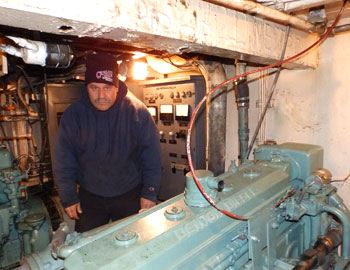 |
|
Naruszewicz in Capt. Log’s engine compartment, with the vessel’s original 170-hp six-cylinder Detroit Diesel 671. |
Another challenge is the fuel deliveries to the 172-foot Governors Island ferry Lt. Samuel S. Coursen.
“You have to get in between the seawall and the ferry,” Naruszewicz said. “It’s a one-shot deal. You have to nose up and get in there. It’s either the flood tide or ebb tide, and you can get sideways. Sometimes we get right in there, and sometimes we get bounced around.”
Like most vessels, Capt. Log has idiosyncracies and the experienced captain uses those to his advantage. “This boat has a left-hand wheel. She backs to starboard,” Naruszewicz said of the tanker’s left-hand pitch. “We come in nice and easy. When we get close, we just drift.”
Some fellow mariners are surprised when they learn that the old tanker runs on a bio-fuel additive. Staten Island-based Bionautics Inc. provides gallon jugs of recycled soybean oil collected from Chinese restaurants in the Bronx. Tri-State Biodiesel puts the old kitchen oil through a transesterification process. The result is a solvent with lubricating and cleansing properties in the 35-year-old diesel engine, said Bionautics owner Paul Lerin.
“The exhaust is so clean, you can read a newspaper through it,” Naruszewicz said.
The harbor tanker’s fuel hose still has its original Westinghouse on/off switch. After each fill-up, Naruszewicz is able to hand over a paper receipt straight from the boat’s Veeder-Root ticket printer.
Then it’s back to its berth at the Circle Line docks at Pier 83. The crew gets ready to do it all again early the next day — usually around 0300.
“We’ve never missed a boat, ever,” Naruszewicz said. “We’re on time, every time.”

